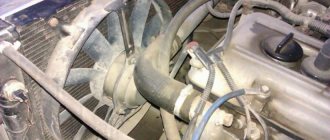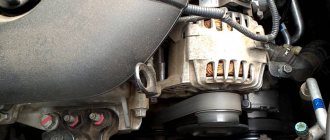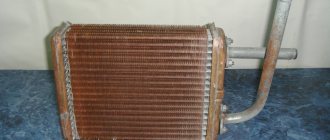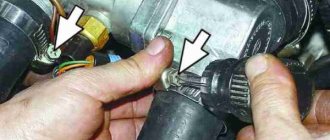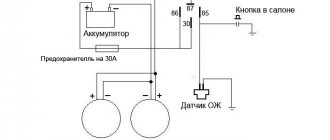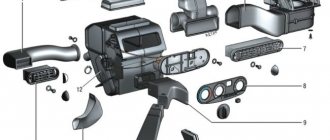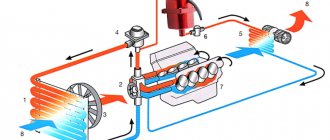Probably, many car enthusiasts have encountered a problem when the lower radiator pipe feels cold to the touch and the upper one is hot. This condition is normal for a car engine that is not warmed up and has not reached the coolant temperature of 80-90 degrees . But if the temperature has reached normal, but the lower pipe is still cold, then you should think about it. Most likely, this is a sign of a malfunction in the car's cooling system.
There may be several reasons for a cold lower radiator pipe when the upper one is hot. Firstly, this is a malfunction of the thermostat or pump. Secondly, you should pay attention to the radiator itself; it may be clogged. Now let's look at each possible problem separately.
What causes the radiator to be cold and the engine to be hot?
There are two types of malfunction symptoms in the cooling system of a car engine: the engine slowly reaches operating temperature or quickly overheats. One of the simplest methods of rough diagnosis is to check with your hand the degree of heating of the upper and lower radiator pipes.
Below we will look at why the internal combustion engine cooling system may not work well and what to do in such situations.
Thermostat
The problem may also be related to the thermostat. This device is small in size and has the ability to block coolant. As a result, problems occur, including those related to the cold pipe.
By the way, the problem with the thermostat also affects the upper pipe. It can also be cold, but the bottom one, on the contrary, can be hot. All this taken together cannot in any way indicate the normal operation of the entire cooling system.
Drain the liquid from the thermostat, loosen its bolts and remove the device.
As a result, we gave three main reasons why this happens. Thus, having found out why the lower radiator pipe is cold, we draw the appropriate conclusions and act according to the situation.
Greetings to all readers on the RtiIvaz.ru blog. The article examines all VAZ radiator pipes that exist today and are used in Lada cars ever produced by the plant.
In any modern car that has a liquid cooling system, all kinds of pipes are used to connect the elements of the system. When operating a car, special attention should be paid to them, since if not noticed in time, a defect that appears can lead to serious consequences for the engine of your car.
From my many years of experience, I can conclude that attention should be paid not only to the pipes themselves, but also to the clamps that serve as a guarantor of the connection. There are cases when a clamp that is not tightened or has come loose ultimately leads to a major overhaul of the engine.
To make it easier for you to navigate the vast “sea” of today’s spare parts, I offer you this review article, which shows everything in detail. For a more complete overview, all presented materials have design numbers and visual photographs.
We start the review with classic models and present the radiator pipes of the VAZ 2101-2105 cooling system, used with a copper radiator, which have a number of advantages over the aluminum radiators used today, namely: the possibility of subsequent repairs, higher heat capacity, longer service life.
The pipes for Lada 2101-2105 cars are presented in the amount of 4 pieces. The upper supply pipe (on the right in the photograph, see further at the end of the article) has a design number: VAZ 2105-1303025 1-one; outlet sleeve (left) 2101-1303010 1-one; thermostat bypass pipe (corner in the middle) 2101-1303090 1-one also coupling connecting the thermostat and water pump (short in the middle) 2105-1303092 1-one piece.
The pipes of the copper radiator of the VAZ differ from the aluminum ones in their size; they have lower “discharge” hoses that are different in shape.
I advise you to pay special attention to the lower outlet pipe during installation. The lower fastening clamp is made technologically in a very inaccessible place and it is very difficult to make a high-quality tightening, which very often causes leakage. In this case, I advise you to completely remove the radiator and assemble the unit separately.
Removal takes no more than 10-15 minutes and will guarantee a reliable tightening. In this case, assemble all the pipes together with the thermostat in place except the upper one and install it in this form on the car. Since they are made of rubber and bend easily, installing the assembled unit is not difficult.
Next, we will consider a set of aluminum radiator pipes for the VAZ classic 2101-2107, also consisting of 4 hoses. The longest one on the far right in the photo is the top one (inlet), with a small angle of inclination the bottom one (outlet), the smallest one (the short one) goes to the thermostat, with an angle of ninety degrees (corner) the one on the far left in the photo goes to the pump.
Design numbers: VAZ 2105—1303025-10 (aluminum upper inlet pipe) 1 piece. 2105-1303010-10 (aluminum bottom outlet pipe) 1 piece. 2105-1303092 (coupling for connecting thermostat and water pump) 1 piece. 2101-1303090 thermostat bypass pipe (angle) 1 piece.
Next comes a set of radiator pipes for VAZ front-wheel drive models and we begin the review from the most common of them, Lada 2109, to the main radiator of the carburetor engine cooling system.
The set of pipes consists of four pieces: the upper inlet (wave) in the middle, see photos, the bottom outlet on the left, see photo, also two short ones (short ones), located on the right, see photos, connecting pipes for the thermostat and the water pump.
Design numbers of the upper supply pipes 2108-1303025 1-one; lower outlet 2108-1303010 1-one; connecting couplings for thermostat and water pump 2108-1303092 2 pieces. The pipes of a carburetor engine differ from the pipes of an injection engine and will be considered separately.
The Lada 2110 car has an injection engine. The set consists of four hoses, and have the following design numbers: upper radiator inlet pipe (in the middle of the photo) VAZ-2110-130302525 1-one and lower radiator outlet pipe (from the left in the photo) 2110-130302510 1-one, and two short thermostat and water pump couplings (on the right in the photo) 2110-1303092 2 pieces.
The upper inlet brings cooled liquid to the radiator at the top, and the lower outlet takes the heated coolant to the bottom of the radiator engine, as happens on most Lada cars.
The VAZ -2115 radiator kit includes three pipes. Design numbers: inlet pipe (on the left in the photo); 21082-1303025 1-one, outlet (in the middle of the photo) 21082-1303010 1-one, connecting pipes for the thermostat and water pump (on the right in the photo) 2109-1303093-01 1-one.
The smallest representative of the VAZ Oka family - 1111 has not been forgotten. The set of small car pipes consists of four hoses: design numbers of the outlet (from the left in the photo) 1111-1303010 1-one; supply (in the middle of the photo) 1111-1303090 1-one; coupling (short) 1111-1303092 1 piece; 2101-1303090 thermostat bypass pipe (angle) one.
And we complete the selection by showing the radiator cooling system pipes for modern classics equipped with an injector. Equipment: VAZ-21073 injection engine.
The upper supply hose (on the left in the photo) has design number VAZ-21073-1303025 1-one; lower outlet pipe 2105-1303010-10 1-one; 2101-1303090 thermostat bypass pipe (angle) one and 2105-1303092 coupling connecting thermostat also water pump 1 piece.
Additionally presented at the end of the article are the filler necks of the VAZ 2110 tank, which is compatible with the entire family of tens, and is slightly different in size from the tank neck of the Lada 2108, we are mutually interchangeable and then we see a picture of the long tank neck of the car 21099 of the family of nines and fourteens.
Copper radiator cooling hoses 2101-2107
Copper radiator cooling system pipes:
The radiator pipe of the VAZ 2101-2105 cooling system of the copper radiator consists of four pipes.
They have design numbers:
- Outlet pipe (number 1 on the left) 2101-1303010 1 piece.
- Thermostat bypass pipe (in the middle is corner number 2) 2101-1303090 1 piece.
- Connecting coupling for the thermostat and water pump (short one in the middle, number 3) 2105-1303092 1 piece.
- Upper pipe supplying VAZ 2105-1303025 1 piece (on the right in the photo under number 4).
The pipes of a copper radiator differ from those of an aluminum radiator in their sizes and the lower “discharge” sleeves are different in shape.
Auto 2101-2107 top view
Side view of the aluminum radiator VAZ 2101-2107
Let's look at the aluminum radiator pipes of the Lada 2101-2107. They are installed on Lada 2101-2107 cars, which have an aluminum radiator. The kit consists of four pipes. The longest one on the far right, see photos, is called the top “supply”, with a small angle of inclination, the bottom “discharge”, the smallest (short) goes to the thermostat and the pipe with an angle of ninety degrees (corner) on the far left, see photos, goes to the pump.
- 2101-1303090 thermostat bypass pipe (angle number 1) 1 piece.
- 2105-1303092 (coupling of the connecting thermostat and water pump number 2) 1 piece.
- 2105-1303010-10 (aluminum radiator outlet pipe, lower number 3) 1 piece.
- VAZ 2105—1303025-10 (supply pipe of the upper aluminum radiator, number 4) 1 piece.
All about the cooling system pipe of the Lada VAZ 2105 aluminum radiator.
Next time we will get acquainted with the hoses of the cooling system of VAZ 2108-21099 carburetor engines.
Top view of VAZ 2109, carburetor engine
Let's look today at the radiator pipes of the Lada VAZ 2109 main radiator of the carburetor engine cooling system.
The set of pipes consists of four pipes of the upper “inlet” (wave) in the middle, see the photo, the lower “outlet” on the left in the photo and two short ones (short) on the right, see the photo, connecting hoses for the thermostat and the water pump.
- Radiator pipe VAZ lower outlet 2108-1303010 1 piece. (number 1).
- Radiator pipe VAZ upper inlet 2108-1303025 1 piece. (wave number 2, see figure).
- Connecting couplings for thermostat and water pump 2108-1303092 2 pieces. (short ones numbered 3 and 4).
I’ll also add that the radiator pipe of a VAZ carburetor engine differs from the pipe of an injection engine.
Next in the photo we will look at the pipe of the Lada 2110 car:
View of the pipe from the side of a VAZ 2110
Let's look at a set of pipes for the cooling system of a Lada 2110 injection engine. The kit consists of four hoses.
- Lower outlet pipe (from the left in the photo under number 1) 2110-130302510 1 piece.
- Upper supply pipe (in the middle of the photo, number 2) VAZ-2110-130302525 1 piece.
- Two short couplings connecting the thermostat and water pump (numbers 3 and 4 on the right in the photo) 2110-1303092 2 pieces.
The upper inlet hose supplies cooled liquid from the radiator from above, and the lower outlet hose removes heated coolant to the bottom of the engine, this happens in most VAZ cars.
Side view of car 2115
The VAZ-2115 radiator kit consists of three pieces.
Radiator hose design numbers:
- “Leading” (on the left of the photo under number 1) 21082-1303025 1 piece.
- “Discharge” (in the middle of photo no. 2) 21082-1303010 1 piece.
- Connecting pipe between thermostat and water pump (on the right, see photo number 3) 2109-1303093-01 1 piece.
Cooling system pipe of the small car Oka VAZ-1111. Consist of four radiator pipes.
- Outlet (from the left, see photo number 1) 1111-1303010 1 piece.
- Leading (see photo number 2 in the middle) 1111-1303090 1 piece.
- Connecting couplings (short number 3) 1111-1303092 1 piece.
- 2101-1303090 thermostat bypass pipe (angle number 4) 1 piece.
Nowadays, cars with carburetor engines are becoming history. In front of you is a photo of a VAZ-21073 injection engine pipe with an aluminum radiator.
VAZ 21073 injection
- Upper supply pipe (on the left, see photo number 1) VAZ-21073-1303025 1 piece.
- 2105-1303092 coupling connecting thermostat and water pump (number 2) 1 piece.
- Outlet pipe of the lower aluminum radiator (number 3): VAZ-2105-1303010-10 1 piece.
- VAZ-2101-1303090 thermostat bypass pipe (angle number 4) 1 piece.
Tank filler neck 2110
The filler neck of the tank of a VAZ 2110 car of the tenth family, it is similar to the tank neck pipe of the 2108, differs slightly in size and is interchangeable.
Filler neck of the tank VAZ 21099
Filler neck of the VAZ 21099 tank for cars of the nines and fourteeners family.
Heater hoses VAZ 2101 inlet hoses number 1 - 2101-8101200 and outlet “L-shaped” number 2 - 2101-8101204
Heater hoses VAZ 1111 Oka large inlet number 3 - 1111-8101202, middle outlet 2 - 2101-8101204 and small inlet number 1 - 1111-8101206
Heater hoses VAZ 2108 inlet “big goose” rear number 1 - 2108-8101206, heater outlet hose rear “small goose” 2 - 2108-8101208, heater outlet hose front “small inside the car” 3 - 2108-8101204, heater hose front inlet “large in the cabin” 4 - 2108-8101200
Heater hoses VAZ 2108 inlet “big goose” rear number 4 - 2114-8101206, heater outlet hose rear “small goose” 3 - 2114-8101208, front heater inlet hose “small in the cabin” 1 - 2114-8101200, heater outlet hose front “large inside the car” 2 - 2114-8101204
Heater inlet hoses “large” number 1 - 2111-8101200 and outlet “small” 2 - 2111-8101208
Heater hoses: outlet "Chevy Niva" number 1 - 2123-8101204 and supply 2 - 2123-8101200
Throttle carburetor heating hose 48 cm - 2112-1148038
Radiator steam exhaust pipe “antifreeze tenth” - 2110-1303095
Filling hose for the expansion tank cooling system - 21082-1303080
Cooling system filling hose “stick” - 2111-1303080
Lower crankcase exhaust ventilation hose “large breather” 2108-1014056-10
Lower crankcase exhaust ventilation hose “large breather” - 2112-1014056
Crankcase exhaust ventilation hose “breather Niva” - 2121-1014056
Exhaust pipe hose “snail 8 cells” - 2111-1148035-10
Exhaust pipe hose “snail 16 cl” - 2112-1148035-10
You can also check out other materials:
Sometimes, even experienced motorists wonder: why is the lower pipe on the VAZ 2114 cold? It is impossible to answer this question unequivocally; there are many reasons that lead to disturbances in the engine cooling system. One thing is clear: it is necessary to find out the cause of the breakdown and restore the system to avoid problems with the engine. Let's try to thoroughly understand everything.
Operating principle of the engine cooling system
Liquid cooling works on the principle of transferring heat to a circulating intermediate agent. It takes energy from the heated areas of the engine and transfers it to the cooler.
Hence the set of elements necessary for this:
- cooling jackets for the block and cylinder head;
- main radiator of the cooling system with expansion tank;
- control thermostat;
- water pump, also known as pump;
- non-freezing liquid - antifreeze;
- forced cooling fan;
- heat exchangers for removing heat from units and the engine lubrication system;
- interior heating radiator;
- optionally installed heating systems, additional valves, pumps and other devices associated with antifreeze flows.
Immediately after starting a cold engine, the system's task is to quickly warm it up in order to minimize the time it operates in suboptimal mode. Therefore, the thermostat blocks the flow of antifreeze through the radiator, returning it after passing through the engine back to the pump inlet.
Moreover, it does not matter where the thermostat valves are installed; if it is closed at the outlet of the radiator, then the liquid will not get there. The turnover occurs in a so-called small circle.
As the temperature rises, the active element of the thermostat begins to move the rod, and the small circle valve gradually closes. Some of the liquid begins to circulate in a large circle, and so on until the thermostat is completely open.
In reality, it opens completely only at maximum thermal load, since this means the limit for the system without the use of additional systems for cooling the internal combustion engine. The very principle of temperature control implies constant control of the intensity of flows.
If, however, the temperature reaches a critical value, this means that the radiator cannot cope, and the air flow through it will be increased by turning on the forced cooling fan.
You must understand that this is more of an emergency mode than a standard one; the fan does not regulate the temperature, but only saves the engine from overheating when the flow of incoming air is low.
Messages 11
1 Topic by Dmitriy.Bobilev 2015-07-07 21:11:34
- Dmitriy.Bobilev
- New member
- Inactive
- Registration: 2014-08-11
- Messages: 4 Thanks : 0
- Auto: 2110
Topic: All pipes are hot, but the engine is overheating
Hello everyone, in general, I have been fighting with CO for a long time, at the moment the symptoms are as follows: At idle, warming up goes as it should, it reaches about 88, the needle freezes, then it heats up like crazy, i.e. while you are driving normal, you just need to stand somewhere and let it work Carlson won’t be left behind later (that is, while you’re stuck in a traffic jam, it will turn on annoyingly every minute, maybe less! It’s worth driving 300-400 meters at speed and again in a circle) while the antifreeze on the small return circle from the larger radiator is normal, as soon as goes to a large trickle less and less, it may disappear altogether, the pump is luzar with an iron impeller, the thermostat is working, the radiator is hot evenly, the pipes are new, there is no air lock. I don’t even know what to look for, where to dig. It is advised to remove the gasket from the pump and place it on sealants in order to reduce the distance between the walls of the block and the impeller. Maybe the problem is still in the radiator? The pump is new.
By the way, the problem persists even in the rain and at an outside temperature of +10
2 Reply from Aleksandr.21124 2015-07-08 06:08:38 (2015-10-02 21:15:44 edited by Aleksandr.21124)
- Aleksandr.21124
- Brother-in-law
- Inactive
- Registration: 2014-08-11
- Messages: 392 Thanks : 169
- Car: VAZ 21124
Re: The pipes are all hot, but the engine is overheating
Dmitriy.Bobilev – Perhaps the radiator is clogged inside (if so, replacing it will help) and the radiator itself on the outside may be clogged with dirt (wash with a Karcher). And if you have a grille or mesh on the bumper below the state number (from flies and dirt), then remove it. And also turn off the two hoses that go to the throttle valve - this is a small circle of hot antifreeze (by turning off the car, it heats up less in hot weather). I switched it off myself and for a year now everything has been working fine both in winter and summer. This heating is not needed (it is removed during conversion) on the electronic throttle valve it is not present.
3 Reply from kuler_78 2015-07-08 07:53:38 (2015-07-08 08:03:29 edited by kuler_78)
- cooler_78
- Experienced
- Inactive
- Registration: 2014-10-22
- Messages: 142 Thanks : 57
Why can the lower radiator hose be cold and the upper hose hot?
There is always a certain temperature difference between the radiator pipes, since this means that part of the energy was sent into the atmosphere. But if, after sufficient heating, one of the hoses remains cold, then this is a sign of a malfunction.
Airlock
The liquid in a normally operating system is incompressible, which ensures its normal circulation by a water pump. If, for various reasons, an airy area has formed in one of the internal cavities - a plug, then the pump will not be able to work normally, and a large temperature difference will arise in different parts of the antifreeze path.
Sometimes it helps to turn the pump up to high speeds so that the plug is expelled into the radiator expansion tank - the highest point of the system - but more often you have to deal with the plugs in other ways.
Most often they occur when the system is filled incorrectly with antifreeze when replacing or topping up. You can bleed air by undocking one of the hoses located at the top, for example, for heating the throttle valve.
Air always collects at the top, it will come out and work will be restored.
It's worse when it's a vapor lock due to local overheating or gas penetration through a broken head gasket. Most likely you will have to resort to diagnostics and repairs.
Coolant pump impeller malfunction
To achieve maximum performance, the pump impeller works to the limit of its capabilities. This means the manifestation of cavitation, that is, the appearance of vacuum bubbles in the flow on the blades, as well as shock loads. The impeller may be completely or partially destroyed.
The circulation will stop, and due to natural convection, hot liquid will accumulate at the top, the bottom of the radiator and the pipe will remain cold. The engine must be stopped immediately, otherwise overheating, boiling and release of antifreeze are inevitable.
The channels in the cooling circuit are clogged
If you do not change the antifreeze for a long time, foreign deposits accumulate in the system, the results of the oxidation of metals and the breakdown of the coolant itself.
Dirty radiator
The main reason for this, according to most experts, is a clogged radiator
. Over time, this important element of the cooling system becomes clogged with rust residue, dust, leaves and other debris. The location of the radiator is in front of the car. So, no matter what happens, it gets inside. Ultimately, all this leads to problems.
Since this reason is the most important, below is a method on how to clean a radiator. In addition, proper care of the radiator and its regular maintenance ensures the normal operation of the entire cooling system.
Once it has been decided to start by flushing the radiator, to eliminate the symptom described above, proceed in different ways:
- Or they go to the store and buy a new radiator;
- Or you can clean it yourself.
Important points:
- The radiator must be cleaned when the engine has completely cooled down;
- It is recommended to wear protective gloves and firmly fasten the car hood;
- All coolant is drained from the radiator and checked. If the liquid is perfectly clean and there are no traces of rust or scale in it, the radiator is clean and the reason for the cold pipe is different;
- If the liquid is dirty, then that's it. Pour clean water (necessarily distilled) inside. We start the engine and let it run for 20 minutes.
- We drain the water, check for cleanliness and, if necessary, repeat the procedure several times.
Coolant replacement
: Often, when replacing the coolant, beginners make a mistake and then complain about a cold pipe. This concerns a situation where the radiator itself is freed from old fluid, but the tank is forgotten. As a result, this affects the entire cooling system. It starts to act up and diagnostics give no clue.
What to do if the lower radiator hose is cold
In most cases, the problem is related to the thermostat. This is potentially the most unreliable element of the system. You can measure the temperature of its pipes using a non-contact digital thermometer, and if the temperature difference exceeds the threshold for the valves to start opening, then the thermostat must be removed and checked, but most likely it will have to be replaced.
The pump impeller fails much less often. This only happens in cases of obvious manufacturing defects. Pumps are also not reliable, but their failure is manifested quite clearly in the form of bearing noise and fluid leakage through the seal. Therefore, they are replaced either prophylactically, based on mileage, or when these very noticeable signs occur.
Other reasons are more difficult to diagnose; it may be necessary to pressure test the system, check it with a scanner, measure the temperature at various points and other research techniques from the arsenal of professional motorists. And most often - taking an anamnesis; cars rarely break down on their own.
Perhaps the car was not looked after, the fluid was not changed, water was added instead of antifreeze, and repairs were entrusted to dubious specialists. The type of expansion tank, the color of the antifreeze in it and the smell will indicate a lot. For example. the presence of exhaust gases means a gasket breakdown.
If the fluid level in the expansion tank suddenly begins to drop, it is not enough to simply top it up. It is necessary to find out the reasons; driving with antifreeze leaking or leaking into the cylinders is strictly forbidden.
Source
Why is the lower radiator hose cold and the upper hose hot?
A hot top and cold bottom of a car radiator is a normal condition only for an unheated engine after starting. If the engine has been running for several minutes, during which the coolant temperature has already reached 80–90 degrees (depending on the model), and the upper radiator pipe is hot and the lower one is cold, this is a sign of a problem in the cooling system. However, there are exceptions to this rule.
The main reasons why the lower radiator hose is cold after warming up are a malfunction of the thermostat or pump , or a clogged radiator . This article will tell you how to determine the specific cause of the problem and what to do in this case.
Cleaning or replacing the radiator
The radiator, located in the front of the car, absorbs the main flow of dust and dirt. For its effective operation, timely prevention and cleaning is necessary. The radiator can become dirty both inside and outside.
An indicator of internal cleanliness is the condition of the coolant. Manufacturers recommend changing antifreeze every 75,000 km or every 5 years. However, a change in the color of the liquid, severe darkening, discoloration, or the presence of rust requires urgent replacement of the coolant. It is recommended to change antifreeze at least every 40,000 km.
To carry out internal cleaning of the cooling system of VAZ 2110, 2114, 2115, it is necessary to drain the liquid. Sequencing:
- open the expansion tank cap;
- place a container to drain the antifreeze;
- Unscrew the drain plug from the cylinder block;
- drain the refrigerant;
- unscrew the radiator drain plug (located at the lowest point);
- drain the remaining antifreeze (antifreeze);
- tighten all the plugs.
To clean, pour distilled water into the system and start the engine for about 20 minutes. Ordinary water contains many impurities and forms scale, so its use is undesirable. The liquid is drained several times until clean water flows out. This method is ineffective as it removes a small amount of deposits.
For more effective washing, it is advisable to use special chemical additives. The detergent components included in their composition allow you to dissolve deposits and remove various types of contaminants. The mixture of water and vinegar used by many motorists is less effective. It does not remove all deposits. After using chemicals, the cooling system is washed with distillate.
After cleaning the entire SOD of the VAZ 2110, 2114, 2115, an additional internal flushing of the radiator is carried out. To do this, you need to detach the hoses from the base and the upper and upper tank. Liquid is poured into the radiator through the upper pipe using a garden hose. Flushing is carried out until clean water flows from the lower pipe.
The removed radiator can be externally cleaned to remove dirt, insects, and sand from the cooler honeycomb. Cleaning is carried out with a soap solution or special devices that create a strong flow of water or air, for example a Karcher vacuum cleaner. The procedure should be carried out carefully so as not to bend the radiator honeycombs.
If damaged or heavily soiled, the radiator should be replaced.
Replacing the thermostat
If the thermostat valve does not operate correctly, the coolant does not circulate throughout the large circle of the ODS. The lower pipe remains cold even after the refrigerant is heated to 90°C. The top pipe may be hot due to steam escaping. The thermostat can also get stuck in the open position; in this case, the engine does not warm up to the required temperature or takes too long to warm up.
In preparation for replacing the device, it is necessary to drain the fluid from the system and remove the air filter. Then the radiator and fluid pump hoses are disconnected from the thermostat housing. After this, loosen the mounting bolts and remove the thermostat cover. The device is replaced with a working one. Attaching the thermostat is done in the reverse order.
These are the main reasons for the malfunction of the cooling system and the cold lower pipe of VAZ 2110, 2114, 2115 cars.
How to determine the reason why the lower radiator hose is cold and the upper one is hot
The lower radiator hose is slightly cooler than the upper one, since the antifreeze coming from above cools down as it passes through the radiator. But, as a rule, we are talking about a relatively small temperature difference. When the outlet pipe/hose from the radiator does not warm up at all, this indicates a violation of the coolant circulation and heat exchange in the internal combustion engine.
All common reasons why a cold lower radiator pipe does not heat up normally are collected in the table.
| Possible reason | Consequence | How to understand/define it |
| The thermostat is stuck in the closed or half-closed position. | The coolant circulates in a small circle and does not cool. |
|
| The expansion tank cap valve is faulty. | The pressure in the circuit is not automatically regulated, which may cause air pockets. |
|
| The radiator channels (lines) are clogged. | Antifreeze does not pass through the radiator and circulates mainly in a small circle. |
|
| The water pump impeller is worn out. | The pump cannot create the required pressure, which causes the coolant circulation and heat transfer from the engine to the radiator to deteriorate. |
|
| There is an air lock in the cooling circuit. | Coolant circulation deteriorates, heat exchange is disrupted, and pipes may swell and rupture. |
|
Cars that most often have heat transfer problems
On some cars, the situation where the upper radiator hose is hot and the lower hose is cold is more common than others. Such models and their “childhood diseases” are collected in the table below.
| Brand, model | Cause of the problem | How can I fix it? |
| VAZ 2106, 2101 and other “Classics” | Low quality of original components, in particular the thermostats themselves, which jam. | Instead of the original VAZ thermostat valve, use parts from other companies: Metal Incar, Finwhale, Vernet. |
| The cold bottom of the radiator in a VAZ “Classic” with high mileage is a consequence of corrosion of parts and clogging of the radiator channels. | Flush the radiator using a special fluid or, if that doesn’t help, replace it. | |
| VAZ 2108-21099, 2113-2115, Kalina | A faulty expansion tank cap valve does not allow maintaining operating pressure in the cooling system, which disrupts coolant circulation and causes the heater to heat poorly. | Replace the expansion tank cap. |
| VAZ 2110 – 2112, Lada Priora | On the VAZ 2110-2112, the lower pipe is cold, and the heater blows cold due to the predisposition to the formation of traffic jams and disruption of coolant circulation. | Monitor the condition of the cooling circuit, remove plugs, especially when replacing antifreeze. As a radical solution, you can replace the thermostat with a “six-hole” one (art. 21082-1306010) or from Lada Granta (21900-1306010), adapting the circuit to it. |
| The upper pipe is heated, and the lower pipe is cold, due to exhaustion and lack of pump performance. | Install an improved pump, like the Luzar Turbo. | |
| Skoda Octavia | On the Skoda Octavia, the lower radiator pipe is cold, and the engine begins to overheat due to a faulty oil heat exchanger gasket. | Replace the oil heat exchanger gasket. |
| Daewoo lanos, Sens, ZAZ Chance | Cold lower pipe and radiator, a consequence of early opening or jamming of the thermostat. | Replace the thermostat with a better one that opens at 87 degrees. |
| Ford Focus | On a Ford Focus, the bottom of the radiator is cold and the top is hot, usually due to a stuck thermostat. | Replace the faulty thermostat. |
| Mazda 3 | On a Mazda 3, the lower pipe is cold, usually due to a faulty thermostat. | |
| Volkswagen Passat | With high mileage, the pump and thermostat fail. | Replace the pump or thermostat. |
| Suzuki Grand Vitara | Airing of the cooling system due to pressure failure. | Remove air pockets. Replace the expansion tank cap, which often becomes clogged or, on the contrary, does not hold pressure. |

